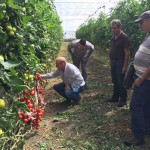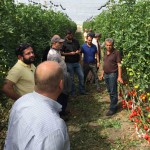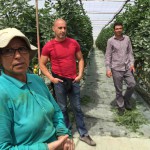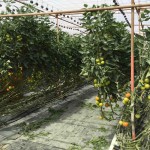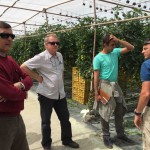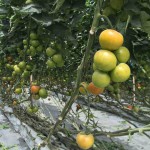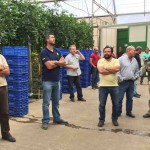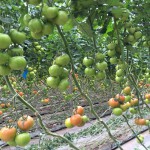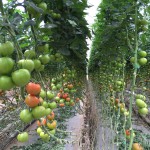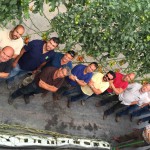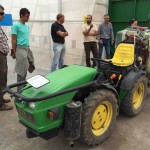 As part of the Technical Conference II Memorial Juan Felix Cabrera.
As part of the Technical Conference II Memorial Juan Felix Cabrera.
Twenty technical / as almost all companies dedicated to export tomato crop in the Canary Islands, they moved to the municipality of La Aldea to participate in the technical conferences organized by the Technical Department of COAGRISAN.
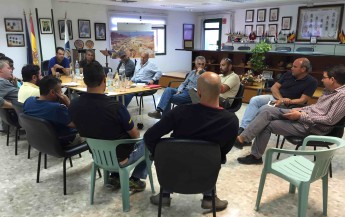 Two have been the cornerstones in the development of the conference focused. On the one hand, meet the new variety of tomato resistant seed the virus Spotted (owner) and, for another, examine and analyze the technical innovations of off-hook to lower greenhouse three meters.
Two have been the cornerstones in the development of the conference focused. On the one hand, meet the new variety of tomato resistant seed the virus Spotted (owner) and, for another, examine and analyze the technical innovations of off-hook to lower greenhouse three meters.
In addition to the broad Catalog pest over the past decade has affected the tomato crop, still it continues to grow with new additions that are the Canary Islands, in particular, a paradise for proliferation.
While technical teams are provided with the means and tools necessary to combat it, They have opted for the exchange of experience and knowledge as a fundamental tool in achieving.
[youtube url=”https://www.youtube.com/watch?v = TBfI_hwLvaQ&feature=youtu.be” width=”500″ height=”300″] This was explained the head of the Technical Department COAGRISAN, Marcelo Rodriguez, after welcoming participants, including technicians Cabildo de Gran Canaria and phytosanitary companies were also, Inca, and providers of integrated control insects, Koppert.
Rodriguez explained that the damage that has been causing thrips in recent years, It has led to a considerable decrease in yields and the quality of them.
For that reason, in collaboration with a seed supply company, They began an investigation to achieve resistance, not tolerance, the virus Tomato spotted wilt transmitted by thrips.
Three years later, and after various tests in the field in areas with greater involvement of the municipality, the findings have been categorical and irrefutable.
The thrips is a small insect that measures between 1 and 2 mm in length with a color ranging from dark brown to light yellow. Saltan, They fly and move with great agility from one place to another.
By biting and sucking tissue content of plant cells, thrips (Frankliniella occidentalis) transmits the tomato spotted wilt virus (HELPFUL) or tomato spotted wilt virus.
It manifests itself in the form of circular spots with tissue death, both sheets, flowers and fruits. Subsequently, the plants stop growing, They lose their natural color and deform. The extent of damage can range from loss of performance to crop destruction.
This new variety of seed follows the line of the 'Marian' variety, but with resistance to the effects of thrips, unique in its kind, It will use the Cooperative COAGRISAN next season.
During the tour the cultures in which they have conducted trials, technicians could check the results and exchange views with the owner of the crop, Dolores Cubas, who said he was delighted that last year and had to start the whole crop. [youtube url=”https://www.youtube.com/watch?= the KRFLojSz8lY&feature=youtu.be” width=”500″ height=”300″]
One of the handicaps available to the tomato export sector today, It is the failure to realize the modernization of infrastructure to achieve greater productivity and, thus, cost effectiveness.
Breaches of administrations with State aid, the drastic cut in compensation to transport and market swing, They have been some of the reasons why producers have not made the changes.
However, the need sharpens the wit and the means available and some slight changes and innovations, infrastructure can be adapted to lift technique without changing it.
In this line technicians COAGRISAN showed the results of the technique known as 'churro' or 'the wave'. This is to allow increased plant growth in those less than three meters tall greenhouses.[youtube url=”https://www.youtube.com/watch?= the qjZmeufyKy0&feature=youtu.be” width=”500″ height=”300″]
Who explained to the positive effects technicians were two farmers who spent the previous model it, and now claim not want to return to the old.
Josefa Llarena, in his greenhouse in El Hoyo, in addition to applying this innovation that says she is very satisfied, It has also opted for the coconut fiber substrate that is reporting it 'great benefits'. With what I've saved in nematicide and soil disinfestation I have covered the cost of the investment, explains Llarena.
[youtube url=”https://www.youtube.com/watch?v = 92Dodlp2LcM&feature=youtu.be” width=”500″ height=”300″]On the other hand, Paulina Ramirez Araujo, in almost 11.000 m2 greenhouse is in the Las Tabladas, declares its satisfaction with the implementation of this technique, although its infrastructure is in an intermediate height for further adapted trucks for tillage.
Greenhouses recent visit of Roberto Suarez were in the ravine of La Arena. This is art structures, multitúnel, hydroponics, recirculation and mechanization of work.
Suarez also has a section of type 'scratchcard amagado' that has adapted to lift, increasing its height up to six meters achieving very similar performance to the next generation.
After the field day, VP COAGRISAN, Rogelio Rodriguez, He encouraged participants technicians to implement some of the innovations that have found during the visit.
Rodriguez recalled that the tests already carried out and results, plus observable, now it socialize and share, which it is one of the objectives we pursued these days.
All participants agreed on the need technicians to influence the training of farmers, especially in such innovations as the inertia of many years back in 'cyst' difficult to eliminate.
However, and in terms of biology, the 'natural attrition' extinguish eventually change those who see it more as a threat than an opportunity, something that has overcome COAGRISAN.



